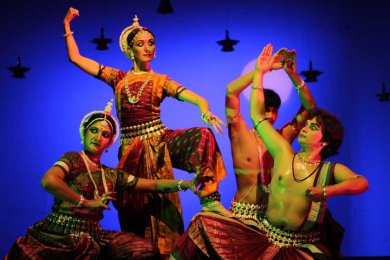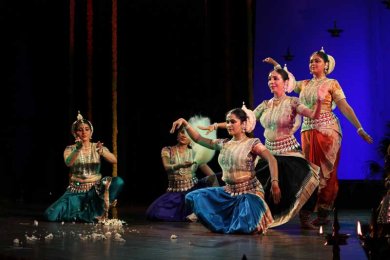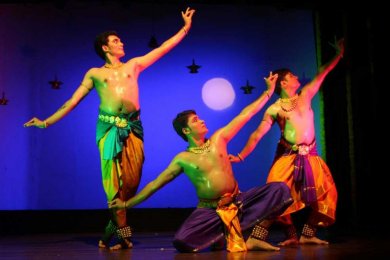
|   |

|   |
 e-mail: sunilkothari1933@gmail.com Rasa Rangini Photos courtesy: Debnrutyam August 10, 2017 Odissi dancer Debasish Pattnaik, a disciple of Guru Durgacharan Ranbir, has moved to Bangalore from Rourkela, establishing Debnrutyam Studio giving training in Odissi to young aspirants. It must be said to the credit of Bangaloreans that they have welcomed Odissi dance form besides Bharatanatyam and Kathak with enthusiasm. Debasish is enterprising. He is maintaining headquarters of Debnrutyam at Rourkela, has established branches at Kochi and is collaborating with dance institutions in Malaysia, Vietnam, Japan, Colombia, Russia and the US. Today, young dancers, with more than 15 years experience, wide travels across various countries, offering workshops, finding disciples from different nationalities anxious to learn Odissi have managed to overcome financial constraints and with the help of local patrons launch branches offering training in Odissi. It requires managerial skills and support from patrons interested in dance. That Debasish has succeeded in receiving support of a large number of patrons, including local Odiya community from Bangalore and established dancers of different forms, was obvious as one attended his first Rasa Rangini 2017 festival, featuring Kuchipudi exponent Vyjayanthi Kashi, her daughter Prateesha and troupe, Sharmila Mukerjee with her Sanjali dancers and Sathyanarayana Raju's three brilliant male dancers along with Debasish's own recital with Russian dancer Elena Kryaseva, Sreelekha Sunil and Shreekanth Kumar Dash. The Seva Sadan Auditorium saw considerable organized effort, right from the announcements to the honouring of the guests, gurus, and patrons to the polished performances not only of his own but also of established dancers without undue delays. Sound training under Guru Durgacharan Ranbir was evident from the very first prayer Jaya Bhagavati Devi Namo Varada of Sage Vyasa, composed by Durgacharan to the music by Sukant Kumar Kundu, rhythm by Dhaneswar Swain and choreographed by Debasish, tailored for the group using the sculptureque images. Extolling Devi's benevolent form, dancers impersonated the goddess, male dancers turning into devotees, Elena as goddess and other female dancer taking other roles, vividly creating tableaux with arresting visuals. In Bajrakanti pallavi in a duet with Elena, Debasish explored mirror images in nritta, sometimes like jugalbandi, one performing and the other responding but with unmistakable stamp of Debaprasad bani, Debasish executing movements with perfection as a male, to the beautiful female dancer Elena. Both the numbers were well executed. Debasish has a good stage presence which is further enhanced by good technique.  Debasish Pattnaik & group  Vyjayanthi Kashi & group Vyjayanthi Kashi in her 'Kanyakumari' dance-drama dwelt upon the mythological story of Kanyakumari, who was born to kill Banasura. When she was born with incomparable beauty, Lord Shiva was enamored and wanted to marry her. Sage Narada had to avert that cleverly as it was announced that when the rooster would speak, the muhurta of marriage would take place. The sun was covered and Kanyakumari on hearing the heralding of morning by rooster, moved to welcome Lord Shiva, but she was deceived. With aakashvani she was consoled that she was to vanquish demon Banasura. She resigns to her fate and kills the demon in a combat. Vyjayanthi in her role of Kanyakumari employed all her dramatic power to bring the character alive, with the sakhis preparing her for her wedding with the Lord. The Kuchipudi form with its catchy rhythm and lilting bobbing up and down movements was seen in full measure. The choreography kept the audience glued to their seats as the episodes followed in quick succession. In keeping with her reputation, the entire troupe danced gracefully. It was gripping from the word go. Sharmila Mukerjee's group choreography of Pallavi in Charukeshi with six female and one male dancer, moved smoothly establishing Kelucharan bani with its graceful movements. Sharmila used one passage of nayika decorating herself, in the other the three dancers playing upon mardala and cymbals and created visuals that stood out in Odissi idiom. Her Ganga with Shankaracharya's composition in Bhatiali raga has been often presented interweaving few episodes of the life of Ganga, her being caught in the matted locks of Lord Shiva and she as Shankaramauliviharini, and as Bhagirathi, Sharmila has employed appropriate movements for the flow. The finale is impressive with dancers holding lamps in hands in descending order of Ganga flowing, winning applause from audience for impressive visual.  Sharmila Mukerjee & group  Sathyanarayana Raju's disciples The evening concluded with Yogesh Kumar, Madhuchandra and Rancy Suhas, three brilliant Bharatanatyam male dancers trained by Sathyanarayana Raju. He has trained them so well that one often had a glimpse of Sathyanarayana's impress in their moves. Oothukadu Venkatasubbaier's stuti saw them in perfect form, bringing out the clean diagonal geometrical lines of Bharatanatyam, Guru Narmada's choreography executed faithfully. Shankaracharya's Shivapanchakshara stuti rendered melodiously by O.S. Arun, gave the three of them enough scope to show their vigorous nritta. The favourite Nagendraharaya, with 'makara' Om Namah Shivaya refrain reinforced the devotion. The synchronization of movements stood out in their well rehearsed presentation. Sancharis for describing Lord Shiva as Nilakantha were well enacted. The finale with Purandaradasa's devarnama dwelt upon Krishna's beauty and praise, familiar to Kannadiga audiences. The trio did justice in performing it with complete involvement. Their body lines, symmetry, alignments all coalesced in an interesting manner. Bangalore has a large number of male dancers who excel in Bharatanatyam and these three dancers reiterated their faith in pursuing the dance form. The first edition of Rasa Rangini was successful in its premier attempt. One would like to suggest that to showcase his own talent, Debasish should present more dance numbers of Deba Prasad bani which is vibrant and enjoyable.  Dr. Sunil Kothari is a dance historian, scholar, author and critic and fellow, Sangeet Natak Akademi. Post your comments Please provide your name and email id when you use the Anonymous profile in the blog to post a comment. All appropriate comments posted with name & email id in the blog will also be featured in the site. |